neural networks in finance gaining predictive edge in the market [mcnelis p d ]
Bạn đang xem bản rút gọn của tài liệu. Xem và tải ngay bản đầy đủ của tài liệu tại đây (3.38 MB, 261 trang )
Neural Networks in Finance:
Gaining Predictive Edge
in the Market
Neural Networks
in Finance:
Gaining
Predictive Edge
in the Market
Paul D. McNelis
Amsterdam • Boston • Heidelberg • London • New York • Oxford
Paris
• San Diego • San Francisco • Singapore • Sydney • Tokyo
Elsevier Academic Press
30 Corporate Drive, Suite 400, Burlington, MA 01803, USA
525 B Street, Suite 1900, San Diego, California 92101-4495, USA
84 Theobald’s Road, London WC1X 8RR, UK
This book is printed on acid-free paper.
Copyright
c
2005, Elsevier Inc. All rights reserved.
No part of this publication may be reproduced or transmitted in any form or by any means, electronic
or mechanical, including photocopy, recording, or any information storage and retrieval system,
without permission in writing from the publisher.
Permissions may be sought directly from Elsevier’s Science & Technology Rights Department in
Oxford, UK: phone: (+44) 1865 843830, fax: (+44) 1865 853333,
e-mail: You may also complete your request on-line via the Elsevier
homepage (), by selecting “Customer Support” and then “Obtaining Permissions.”
Library of Congress Cataloging-in-Publication Data
McNelis, Paul D.
Neural networks in finance : gaining predictive edge in the market / Paul D. McNelis.
p. cm.
1. Finance–Decision making–Data processing. 2. Neural networks (Computer science) I. Title.
HG4012.5.M38 2005
332
.0285
632–dc22
2004022859
British Library Cataloguing in Publication Data
A catalogue record for this book is available from the British Library
ISBN: 0-12-485967-4
For all information on all Elsevier Academic Press publications
visit our Web site at www.books.elsevier.com
Printed in the United States of America
040506070809 987654321
Contents
Preface xi
1 Introduction 1
1.1 Forecasting, Classification, and Dimensionality
Reduction 1
1.2 Synergies 4
1.3 The Interface Problems 6
1.4 Plan of the Book 8
I Econometric Foundations 11
2 What Are Neural Networks? 13
2.1 Linear Regression Model 13
2.2 GARCH Nonlinear Models 15
2.2.1 Polynomial Approximation 17
2.2.2 Orthogonal Polynomials 18
2.3 Model Typology 20
2.4 What Is A Neural Network? 21
2.4.1 Feedforward Networks 21
2.4.2 Squasher Functions 24
2.4.3 Radial Basis Functions 28
2.4.4 Ridgelet Networks 29
2.4.5 Jump Connections 30
2.4.6 Multilayered Feedforward Networks 32
vi Contents
2.4.7 Recurrent Networks 34
2.4.8 Networks with Multiple Outputs 36
2.5 Neural Network Smooth-Transition Regime Switching
Models 38
2.5.1 Smooth-Transition Regime Switching Models . . . 38
2.5.2 Neural Network Extensions 39
2.6 Nonlinear Principal Components: Intrinsic
Dimensionality 41
2.6.1 Linear Principal Components 42
2.6.2 Nonlinear Principal Components 44
2.6.3 Application to Asset Pricing 46
2.7 Neural Networks and Discrete Choice 49
2.7.1 Discriminant Analysis 49
2.7.2 Logit Regression 50
2.7.3 Probit Regression 51
2.7.4 Weibull Regression 52
2.7.5 Neural Network Models for Discrete Choice 52
2.7.6 Models with Multinomial Ordered Choice 53
2.8 The Black Box Criticism and Data Mining 55
2.9 Conclusion 57
2.9.1 MATLAB Program Notes 58
2.9.2 Suggested Exercises 58
3 Estimation of a Network with Evolutionary Computation 59
3.1 Data Preprocessing 59
3.1.1 Stationarity: Dickey-Fuller Test 59
3.1.2 Seasonal Adjustment: Correction for Calendar
Effects 61
3.1.3 Data Scaling 64
3.2 The Nonlinear Estimation Problem 65
3.2.1 Local Gradient-Based Search: The Quasi-Newton
Method and Backpropagation 67
3.2.2 Stochastic Search: Simulated Annealing 70
3.2.3 Evolutionary Stochastic Search: The Genetic
Algorithm 72
3.2.4 Evolutionary Genetic Algorithms 75
3.2.5 Hybridization: Coupling Gradient-Descent,
Stochastic, and Genetic Search Methods 75
3.3 Repeated Estimation and Thick Models 77
3.4 MATLAB Examples: Numerical Optimization and
Network Performance 78
3.4.1 Numerical Optimization 78
3.4.2 Approximation with Polynomials and
Neural Networks 80
Contents vii
3.5 Conclusion 83
3.5.1 MATLAB Program Notes 83
3.5.2 Suggested Exercises 84
4 Evaluation of Network Estimation 85
4.1 In-Sample Criteria 85
4.1.1 Goodness of Fit Measure 86
4.1.2 Hannan-Quinn Information Criterion 86
4.1.3 Serial Independence: Ljung-Box and McLeod-Li
Tests 86
4.1.4 Symmetry 89
4.1.5 Normality 89
4.1.6 Neural Network Test for Neglected Nonlinearity:
Lee-White-Granger Test 90
4.1.7 Brock-Deckert-Scheinkman Test for Nonlinear
Patterns 91
4.1.8 Summary of In-Sample Criteria 93
4.1.9 MATLAB Example 93
4.2 Out-of-Sample Criteria 94
4.2.1 Recursive Methodology 95
4.2.2 Root Mean Squared Error Statistic 96
4.2.3 Diebold-Mariano Test for Out-of-Sample Errors . . 96
4.2.4 Harvey, Leybourne, and Newbold Size Correction
of Diebold-Mariano Test 97
4.2.5 Out-of-Sample Comparison with Nested Models . . 98
4.2.6 Success Ratio for Sign Predictions: Directional
Accuracy 99
4.2.7 Predictive Stochastic Complexity 100
4.2.8 Cross-Validation and the .632 Bootstrapping
Method 101
4.2.9 Data Requirements: How Large for Predictive
Accuracy? 102
4.3 Interpretive Criteria and Significance of Results 104
4.3.1 Analytic Derivatives 105
4.3.2 Finite Differences 106
4.3.3 Does It Matter? 107
4.3.4 MATLAB Example: Analytic and Finite
Differences 107
4.3.5 Bootstrapping for Assessing Significance 108
4.4 Implementation Strategy 109
4.5 Conclusion 110
4.5.1 MATLAB Program Notes 110
4.5.2 Suggested Exercises 111
viii Contents
II Applications and Examples 113
5 Estimating and Forecasting with Artificial Data 115
5.1 Introduction 115
5.2 Stochastic Chaos Model 117
5.2.1 In-Sample Performance 118
5.2.2 Out-of-Sample Performance 120
5.3 Stochastic Volatility/Jump Diffusion Model 122
5.3.1 In-Sample Performance 123
5.3.2 Out-of-Sample Performance 125
5.4 The Markov Regime Switching Model 125
5.4.1 In-Sample Performance 128
5.4.2 Out-of-Sample Performance 130
5.5 Volatality Regime Switching Model 130
5.5.1 In-Sample Performance 132
5.5.2 Out-of-Sample Performance 132
5.6 Distorted Long-Memory Model 135
5.6.1 In-Sample Performance 136
5.6.2 Out-of-Sample Performance 137
5.7 Black-Sholes Option Pricing Model: Implied Volatility
Forecasting 137
5.7.1 In-Sample Performance 140
5.7.2 Out-of-Sample Performance 142
5.8 Conclusion 142
5.8.1 MATLAB Program Notes 142
5.8.2 Suggested Exercises 143
6 Times Series: Examples from Industry and Finance 145
6.1 Forecasting Production in the Automotive Industry . . . 145
6.1.1 The Data 146
6.1.2 Models of Quantity Adjustment 148
6.1.3 In-Sample Performance 150
6.1.4 Out-of-Sample Performance 151
6.1.5 Interpretation of Results 152
6.2 Corporate Bonds: Which Factors Determine the
Spreads? 156
6.2.1 The Data 157
6.2.2 A Model for the Adjustment of Spreads 157
6.2.3 In-Sample Performance 160
6.2.4 Out-of-Sample Performance 160
6.2.5 Interpretation of Results 161
Contents ix
6.3 Conclusion 165
6.3.1 MATLAB Program Notes 166
6.3.2 Suggested Exercises 166
7 Inflation and Deflation: Hong Kong and Japan 167
7.1 Hong Kong 168
7.1.1 The Data 169
7.1.2 Model Specification 174
7.1.3 In-Sample Performance 177
7.1.4 Out-of-Sample Performance 177
7.1.5 Interpretation of Results 178
7.2 Japan 182
7.2.1 The Data 184
7.2.2 Model Specification 189
7.2.3 In-Sample Performance 189
7.2.4 Out-of-Sample Performance 190
7.2.5 Interpretation of Results 191
7.3 Conclusion 196
7.3.1 MATLAB Program Notes 196
7.3.2 Suggested Exercises 196
8 Classification: Credit Card Default and Bank Failures 199
8.1 Credit Card Risk 200
8.1.1 The Data 200
8.1.2 In-Sample Performance 200
8.1.3 Out-of-Sample Performance 202
8.1.4 Interpretation of Results 203
8.2 Banking Intervention 204
8.2.1 The Data 204
8.2.2 In-Sample Performance 205
8.2.3 Out-of-Sample Performance 207
8.2.4 Interpretation of Results 208
8.3 Conclusion 209
8.3.1 MATLAB Program Notes 210
8.3.2 Suggested Exercises 210
9 Dimensionality Reduction and Implied Volatility
Forecasting 211
9.1 Hong Kong 212
9.1.1 The Data 212
9.1.2 In-Sample Performance 213
9.1.3 Out-of-Sample Performance 214
x Contents
9.2 United States 216
9.2.1 The Data 216
9.2.2 In-Sample Performance 216
9.2.3 Out-of-Sample Performance 218
9.3 Conclusion 219
9.3.1 MATLAB Program Notes 220
9.3.2 Suggested Exercises 220
Bibliography 221
Index 233
Preface
Adjusting to the power of the Supermarkets and the Electronic Herd requires
a whole different mind-set for leaders
Thomas Friedman, The Lexus and the Olive Tree,p.138
Questions of finance and market success or failure are first and foremost
quantitative. Applied researchers and practitioners are interested not only
in predicting the direction of change but also how much prices, rates of
return, spreads, or likelihood of defaults will change in response to changes
in economic conditions, policy uncertainty, or waves of bullish and bearish
behavior in domestic or foreign markets. For this reason, the premium is on
both the precision of the estimates of expected rates of return, spreads, and
default rates, as well as the computational ease and speed with which these
estimates may be obtained. Finance and market research is both empirical
and computational.
Peter Bernstein (1998) reminds us in his best-selling book Against the
Gods, that the driving force behind the development of probability theory
was the precise calculation of odds in games of chance. Financial markets
represent the foremost “games of chance” today, and there is no reason to
doubt that the precise calculation of the odds and the risks in this global
game is the driving force in quantitative financial analysis, decision making,
and policy evaluation.
Besides precision, speed of computation is of paramount importance in
quantitative financial analysis. Decision makers in business organizations
or in financial institutions do not have long periods of time to wait before
having to commit to buy or sell, set prices, or make investment decisions.
xii Preface
While the development of faster and faster computer hardware has helped
to minimize this problem, the specific way of conceptualizing problems
continues to play an important role in how quickly reliable results may be
obtained. Speed relates both to computational hardware and software.
Forecasting, classification of risk, and dimensionality reduction or distil-
lation of information from dispersed signals in the market, are three tools
for effective portfolio management and broader decision making in volatile
markets yielding “noisy” data. These are not simply academic exercises.
We want to forecast more accurately to make better decisions, such as to
buy or sell particular assets. We are interested in how to measure risk,
such as classifying investment opportunities as high or low risk, not only to
rebalance a portfolio from more risky to less risky assets, but also to price
or compensate for risk more accurately.
Even in a policy context, decisions have to be made in the context of
many disparate signals coming from volatile or evolving financial markets.
As Othmar Issing of the European Central Bank noted, “disturbances have
to be evaluated as they come about, according to their potential for propa-
gation, for infecting expectations, for degenerating into price spirals” [Issing
(2002), p. 21].
How can we efficiently distill information from these market signals for
better diversification and effective hedging, or even better stabilization
policy? All of these issues may be addressed very effectively with neural
network methods. Neural networks help us to approximate or “engineer”
data, which, in the words of Wolkenhauer, is both the “art of turn-
ing data into information” and “reasoning about data in the presence of
uncertainty” [Wolkenhauer (2001), p. xii]. This book is about predictive
accuracy with neural networks, encompassing forecasting, classification,
and dimensionality reduction, and thus involves data engineering.
1
The benchmark against which we compare neural network performance
is the time-honored linear regression model. This model is the starting
point of any econometric modeling course, and is the standard workhorse in
econometric forecasting. While there are doubtless other nonlinear methods
against which we can compare the performance of neural network methods,
we choose the linear model simply because it is the most widely used and
most familiar method of applied researchers for forecasting. The neural
network is the nonlinear alternative.
Most of modern finance theory comes from microeconomic optimization
and decision theory under uncertainty. Economics was originally called the
“dismal science” in the wake of John Malthus’s predictions about the rel-
ative rates of growth of population and food supply. But economics can
be dismal in another sense. If we assume that our real-world observations
1
Financial engineering more properly focuses on the design and arbitrage-free pricing
of financial products such as derivatives, options, and swaps.
Preface xiii
come from a linear data generating process, that most shocks are from
an underlying normal distribution and represent small deviations around
a steady state, then the standard tools of classical regression are perfectly
appropriate. However, making use of the linear model with normally gen-
erated disturbances may lead to serious misspecification and mispricing of
risk if the real world deviates significantly from these assumptions of lin-
earity and normality. This is the dismal aspect of the benchmark linear
approach widely used in empirical economics and finance.
Neural network methods, coming from the brain science of cognitive
theory and neurophysiology, offer a powerful alternative to linear models for
forecasting, classification, and risk assessment in finance and economics. We
can learn once more that economics and finance need not remain “dismal
sciences” after meeting brain science.
However, switching from linear models to nonlinear neural network alter-
natives (or any nonlinear alternative) entails a cost. As we discuss in
succeeding chapters, for many nonlinear models there are no “closed form”
solutions. There is the ever-present danger of finding locally optimal rather
than globally optimal solutions for key problems. Fortunately, we now
have at our disposal evolutionary computation, involving the use of genetic
algorithms. Using evolutionary computation with neural network models
greatly enhances the likelihood of finding globally optimal solutions, and
thus predictive accuracy.
This book attempts to give a balanced critical review of these methods,
accessible to students with a strong undergraduate exposure to statistics,
econometrics, and intermediate economic theory courses based on calculus.
It is intended for upper-level undergraduate students, beginning gradu-
ate students in economics or finance, and professionals working in business
and financial research settings. The explanation attempts to be straightfor-
ward: what these methods are, how they work, and what they can deliver
for forecasting and decision making in financial markets. The book is not
intended for ordinary M.B.A. students, but tries to be a technical expos´e
of a state-of-the-art theme for those students and professionals wishing to
upgrade their technical tools.
Of course, readers will have to stretch, as they would in any good chal-
lenging course in statistics or econometrics. Readers who feel a bit lost
at the beginning should hold on. Often, the concepts become much clearer
when the applications come into play and when they are implemented com-
putationally. Readers may have to go back and do some further review of
their statistics, econometrics, or even calculus to make sense of and see the
usefulness of the material. This is not a bad thing. Often, these subjects
are best learned when there are concrete goals in mind. Like learning a lan-
guage, different parts of this book can be mastered on a need-to-know basis.
There are several excellent books on financial time series and finan-
cial econometrics, involving both linear and nonlinear estimation and
xiv Preface
forecasting methods, such as Campbell, Lo, and MacKinlay (1997); Frances
and van Dijk (2000); and Tsay (2002). In additional to very careful and
user-friendly expositions of time series econometrics, all of these books have
introductory treatments of neural network estimation and forecasting. This
work follows up these works with expanded treatment, and relates neural
network methods to the concepts and examples raised by these authors.
The use of the neural network and the genetic algorithm is by its nature
very computer intensive. The numerical illustrations in this book are based
on the MATLAB programming code. These programs are available on the
website at Georgetown University, www.georgetown.edu/mcnelis. For those
who do not wish to use MATLAB but want to do computation, Excel add-in
macros for the MATLAB programs are an option for further development.
Making use of either the MATLAB programs or the Excel add-in pro-
grams will greatly facilitate intuition and comprehension of the methods
presented in the following chapters, and will of course enable the reader
to go on and start applying these methods to more immediate problems.
However, this book is written with the general reader in mind — there
is no assumption of programming knowledge, although a few illustrative
MATLAB programs appear in the text. The goal is to help the reader
understand the logic behind the alternative approaches for forecasting, risk
analysis, and decision-making support in volatile financial markets.
Following Wolkenhauer (2001), I struggled to impose a linear ordering
on what is essentially a web-like structure. I know my success in this can
be only partial. I encourage readers to skip ahead to find more illustrative
examples of the concepts raised in earlier parts of the book in succeeding
chapters.
I show throughout this book that the application of neural network
approximation coupled with evolutionary computational methods for esti-
mation have a predictive edge in out-of-sample forecasting. This predictive
edge is relative to standard econometric methods. I do not claim that
this predictive edge from neural networks will always lead to opportuni-
ties for profitable trading [see Qi (1999)], but any predictive edge certainly
enhances the chance of finding such opportunities.
This book grew out of a large and continuing series of lectures given in
Latin America, Asia, and Europe, as well as from advanced undergraduate
seminars and graduate-level courses at Georgetown University and Boston
College. In Latin America, the lectures were first given in S˜ao Paulo, Brazil,
under the sponsorship of the Brazilian Association of Commercial Bankers
(ABBC), in March 1996. These lectures were offered again in March 1997
in S˜ao Paulo, in August 1998 at Banco do Brasil in Brasilia, and later that
year in Santiago, Chile, at the Universidad Alberto Hurtado.
In Asia and Europe, similar lectures took place at the Monetary Policy
and Economic Research Department of Bank Indonesia, under the spon-
sorship of the United States Agency for International Development, in
Preface xv
January 1996. In May 1997 a further series of lectures on this subject
took place under the sponsorship of the Programme for Monetary and
Financial Studies of the Department of Economics of the University of
Melbourne, and in March of 1998 a similar course was offered at the
Facultat d’Economia of the Universitat Ramon Llull sponsored by the
Callegi d’Economistes de Calalunya in Barcelona.
The Center for Latin American Economics of the Research Department
of the Federal Reserve Bank of Dallas provided the opportunity in the
autumn of 1997 to do some of the initial formal research for the financial
examples illustrated in this book. In 2003 and early 2004, the Hong Kong
Institute of Monetary Research was the center for a summer of research on
applications of neural network methods for forecasting deflationary cycles
in Hong Kong, and in 2004 the School of Economics and Social Sciences
at Singapore Management University and the Institute of Mathematical
Sciences at the National University of Singapore were hosts for a seminar
and for research on nonlinear principal components
Some of the most useful inputs for the material for this book came
from discussions with participants at the International Joint Conference
on Neural Networks (IJCNN) meetings in Washington, DC, in 2001, and
in Honolulu and Singapore in 2002. These meetings were eye-openers for
anyone trained in classical statistics and econometrics and illustrated the
breadth of applications of neural network research.
I wish to thank my fellow Jesuits at Georgetown University and in
Washington, DC, who have been my “company” since my arrival at George-
town in 1977, for their encouragement and support in my research under-
takings. I also acknowledge my colleagues and students at Georgetown
University, as well as economists at the universities, research institutions,
and central banks I have visited, for their questions and criticism over the
years. We economists are not shy about criticizing one another’s work,
but for me such criticism has been more gain than pain. I am particularly
grateful to the reviewers of earlier versions of this manuscript for Elsevier
Academic Press. Their constructive comments gave me new material to
pursue and enhanced my own understanding of neural networks.
I dedicate this book to the first member of the latest generation of my
clan, Reese Anthony Snyder, born June 18, 2002.
1
Introduction
1.1 Forecasting, Classification, and
Dimensionality Reduction
This book shows how neural networks may be put to work for more accurate
forecasting, classification, and dimensionality reduction for better decision
making in financial markets — particularly in the volatile emerging markets
of Asia and Latin America, but also in domestic industrialized-country asset
markets and business environments.
The importance of better forecasting, classification methods, and dimen-
sionality reduction methods for better decision making, in the light of
increasing financial market volatility and internationalized capital flows,
cannot be overexaggerated. The past two decades have witnessed extreme
macroeconomic instability, first in Latin America and then in Asia. Thus,
both financial analysts and decision makers cannot help but be interested
in predicting the underlying rates of return and spreads, as well as the
default rates, in domestic and international credit markets.
With the growth of the market in financial derivatives such as call and
put options (which give the right but not the obligation to buy or sell assets
at given prices at preset future periods), the pricing of instruments for hedg-
ing positions on underlying risky assets and optimal portfolio diversification
have become major activities in international investment institutions. One
of the key questions facing practitioners in financial markets is the correct
pricing of new derivative products as demand for these instruments grows.
2 1. Introduction
To put it bluntly, if practitioners in these markets do not wish to be “taken
to the cleaners” by international arbitrageurs and risk management spe-
cialists, then they had better learn how to price their derivative offerings
in ways that render them arbitrage-free. Correct pricing of risk, of course,
crucially depends on the correct understanding of the process driving the
underlying rates of return. So correct pricing requires the use of models
that give relatively accurate out-of-sample forecasts.
Forecasting simply means understanding which variables lead or help to
predict other variables, when many variables interact in volatile markets.
This means looking at the past to see what variables are significant lead-
ing indicators of the behavior of other variables. It also means a better
understanding of the timing of lead–lag relations among many variables,
understanding the statistical significance of these lead–lag relationships,
and learning which variables are the more important ones to watch as
signals for further developments in other returns.
Obviously, if we know the true underlying model generating the data we
observe in markets, we will know how to obtain the best forecasts, even
though we observe the data with measurement error. More likely, how-
ever, the true underlying model may be too complex, or we are not sure
which model among many competing ones is the true one. So we have to
approximate the true underlying model by approximating models. Once
we acknowledge model uncertainty, and that our models are approxima-
tions, neural network approaches will emerge as a strong competitor to the
standard benchmark linear model.
Classification of different investment or lending opportunities as accept-
able or unacceptable risks is a familiar task in any financial or business
organization. Organizations would like to be able to discriminate good from
bad risks by identifying key characteristics of investment candidates. In a
lending environment, a bank would like to identify the likelihood of default
on a car loan by readily identifiable characteristics such as salary, years in
employment, years in residence, years of education, number of dependents,
and existing debt. Similarly, organizations may desire a finer grid for dis-
criminating, from very low, to medium, to very high unacceptable risk, to
manage exposure to different types of risk. Neural nets have proven to be
very effective classifiers — better than the state-of-the-art methods based
on classical statistical methods.
1
Dimensionality reduction is also a very important component in financial
environments. All too often we summarize information about large amounts
of data with averages, means, medians, or trimmed means, in which a given
1
Of course, classification has wider applications, especially in the health sciences. For
example, neural networks have proven very useful for detection of high or low risks of
various forms of cancer, based on information from blood samples and imaging.
1.1 Forecasting, Classification, and Dimensionality Reduction 3
percentage of high and low extreme values are eliminated from the sam-
ple. The Dow-Jones Industrial Average is simply that: an average price of
industrial share prices. Similarly the Standard and Poor 500 is simply the
average price of the largest 500 share prices. But averages can be mislead-
ing. For example, one student receiving a B grade in all her courses has a
B average. Another student may receive A grades in half of his courses and
a C grade in the rest. The second student also has a B average, but the
performances of the two students are very different. While the grades of
the first student cluster around a B grade, the grades of the second student
cluster around two grades: an A and a C. It is very important to know
if the average reported in the news truly represents where the market is
through dimensionality reduction if it is to convey meaningful information.
Forecasting into the future, or out-of-sample predictions, as well as clas-
sification and dimensionality reduction models, must go beyond diagnostic
examination of past data. We use the coefficients obtained from past data
to fit new data and make predictions, classification, and dimensionality
reduction decisions for the future. As the saying goes, life must be under-
stood looking backwards, but must be lived looking forward. The past
is certainly helpful for predicting the future, but we have to know which
approximating models to use, in combination with past data, to predict
future events. The medium-term strategy of any enterprise depends on the
outlook in the coming quarters for both price and quantity developments
in its own industry. The success of any strategy depends on how well the
forecasts guiding the decision makers work.
Diagnostic and forecasting methods feed back in very direct ways to
decision-making environments. Knowing what determines the past, as well
as what gives good predictions for the future, gives decision makers better
information for making optimal decisions over time. In engineering terms,
knowing the underlying “laws of motion” of key variables in a dynamic
environment leads to the development of optimal feedback rules. Applying
this concept to finance, if the Fed raises the short-term interest rate, how
should portfolio managers shift their assets? Knowing how the short-term
rates affect a variety of rates of return and how they will affect the future
inflation rate can lead to the formulation of a reaction function, in which
financial officers shift from risky assets to higher-yield, risk-free assets. We
call such a policy function, based on the “laws of motion” of the system,
control. Business organizations by their nature are interested in diagnostics
and prediction so that they may formulate policy functions for effective
control of their own future welfare.
Diagnostic examination of past data, forecasting, and control are differ-
ent activities but are closely related. The policy rule for control, of course,
need not be a hard and fast mechanical rule, but simply an operational
guide for better decision making. With good diagnostics and forecasting,
for example, businesses can better assess the effects of changes in their
4 1. Introduction
prices on demand, as well as the likely response of demand to external
shocks, and thus how to reset their prices. So it should not be so surprising
that good predictive methods are at a premium in research departments
for many industries.
Accurate forecasting methods are crucial for portfolio management by
commercial and investment banks. Assessing expected returns relative
to risk presumes that portfolio strategists understand the distribution of
returns. Until recently, most of the control or decision-making analysis has
been based on linear dynamic models with normal or log-normal distri-
butions of asset returns. However, finding such a distribution in volatile
environments means going beyond simple assumptions of normality or log
normality used in conventional models of portfolio strategies. Of course,
when we let go of normality, we must get our hands dirty in numeri-
cal approximation, and can no longer plug numbers into quick formulae
based on normal distributions. But there are clear returns from this extra
effort.
The message of this book is that business and financial decision makers
now have available the computational power and methods for more accu-
rate diagnostics, forecasting, and control in volatile, increasingly complex,
multidimensional environments. Researchers need no longer confine them-
selves to linear or log-linear models, or assume that underlying stochastic
processes are Gaussian or normal in order to obtain forecasts and pinpoint
risk–return trade-offs. In short, we can go beyond linearity and normality
in our assumptions with the use of neural networks.
1.2 Synergies
The activities of formal diagnostics and forecasting and practical decision
making or control in business and finance complement one another, even
though mastering each of them requires different types of skills and the
exercise or use of different but related algorithms. Applying diagnostic
and predictive methods requires knowledge of particular ways to filter or
preprocess data for optimum convergence, as well as for estimation, to
achieve good diagnostics and out-of-sample accuracy. Decision making in
finance, such as buying or selling or setting the pricing of different types of
instruments, requires the use of specific assumptions about how to classify
risk and about the preferences of investors regarding risk–return trade-offs.
Thus, the outcomes crucially depend on the choice of the preference or
welfare index about acceptable risk and returns over time.
From one perspective, the influence is unidirectional, proceeding from
diagnostic and forecasting methods to business and financial decision mak-
ing. Diagnostics and forecasting simply provide the inputs or stylized facts
about expected rates of return and their volatility. These forecasts are the
1.2 Synergies 5
crucial ingredients for pricing decisions, both for firm products and for
financial instruments such as call or put options and other more exotic
types of derivatives.
From another perspective, however, there may be feedback or bidirec-
tional influence. Knowledge of the objective functions of managers, or their
welfare indices, from survey expectations of managers, may be useful lead-
ing indicators in forecasting models, particularly in volatile environments.
Similarly, the estimated risk, or volatility, derived from forecasting models
and the implied risk, given by the pricing decisions of call or put options or
swaps in financial markets, may sharply diverge when there is a great deal of
uncertainty about the future course of the economy. In both of these cases,
the information calculated from survey expectations or from the implied
volatilities given by prices of financial derivatives may be used as additional
instruments for improving the performance of forecasting models for the
underlying rates of return. We may even be interested in predicting the
implied volatilities coming from options prices.
Similarly, deciding what price index to use for measuring and forecast-
ing inflation may depend on what the end user of this information intends
to do. If the purpose is to help the monetary authority monitor inflation-
ary pressures for setting policy, then price indices that have a great deal
of short-term volatility may not be appropriate. In this case, the overly
volatile measure of the price level may induce overreactions in the setting
of short-term interest rates. By the same token, a price measure that is too
smooth may lead to a very passive monetary policy that fails to dampen
rising inflationary pressures. Thus, it is useful to distill information from
a variety of price indices, or rates of return, to find the movement of the
market or the fundamental driving force. This can be done very effectively
with neural network approaches.
Unlike hard sciences such as physics or engineering, the measurement
and statistical procedures of diagnostics and forecasting are not so cleanly
separable from the objectives of the researchers, decision makers, and
players in the market. This is a subtle but important point that needs
to be emphasized. When we formulate approximating models for the rates
of return in financial markets, we are in effect attempting to forecast the
forecasts of others. Rates of return rise or fall in reaction to changes in
public or private news, because traders are reacting to news and buying
or selling assets. Approximating the true underlying model means taking
into account, as we formulate our models, how traders — human beings like
us — actually learn, process information, and make decisions.
Recent research in macroeconomics by Sargent (1997, 1999), to be dis-
cussed in greater detail in the following section, has drawn attention to
the fact that the decision makers we wish to approximate with our mod-
els are not fully rational, and thus “all-knowing,” about their financial
environment. Like us, they have to learn what is going on. For this very
6 1. Introduction
reason, neural network methods are a natural starting point for approx-
imation in financial markets. Neural networks grew out of the cognitive
and brain science disciplines for approximating how information is pro-
cessed and becomes insight. We illustrate this point in greater detail
when we examine the structure of typical neural network frameworks.
Suffice it to say, neural network analysis is becoming a key compo-
nent of the epistemology (philosophy of knowledge) implicit in empirical
finance.
1.3 The Interface Problems
The goal of this study is to “break open” the growing literature on neural
networks to make the methods accessible, user friendly, and operational for
the broader population of economists, analysts, and financial professionals
seeking to become more efficient in forecasting. A related goal is to focus
the attention of researchers in the fields of neural networks and related
disciplines, such as genetic algorithms, to areas in which their tools may
have particular advantages over state-of-the-art methods in economics and
finance, and thus may make significant contributions to unresolved issues
and controversies.
Much of the early development of neural network analysis has been
within the disciplines of psychology, neurosciences, and engineering, often
related to problems of pattern recognition. Genetic algorithms, which we
use for empirically implementing neural networks, have followed a similar
pattern of development within applied mathematics, with respect to opti-
mization of dynamic nonlinear and/or discrete systems, moving into the
data engineering field.
Thus there is an understandable interface problem for students and pro-
fessionals whose early formation in economics has been in classical statistics
and econometrics. Many of the terms are simply not familiar, or sound odd.
For example, a model is known as an architecture, and we train rather than
estimate a network architecture. A researcher makes use of a training set
and a test set of data, rather than using in-sample and out-of-sample data.
Coefficients are called weights and constant terms are biases.
Besides these semantic or vocabulary differences, however, many of the
applications in the neural network (and broader artificial intelligence) lit-
erature simply are not relevant for financial professionals, or if relevant, do
not resonate well with the matters at hand. For example, pattern recog-
nition is usually applied to problems of identifying letters of the alphabet
for computational translation in linguistics research. A much more inter-
esting example would be to examine recurring patterns such as “bubbles”
in high-frequency asset returns data, or the pattern observed in the term
structure of interest rates.
1.3 The Interface Problems 7
Similarly, many of the publications on financial markets by neural net-
work researchers have an ad hoc flavor and do not relate to the broader
theoretical infrastructure and fundamental behavioral assumptions used in
economics and finance. For this reason, unfortunately, much of this research
is not taken seriously by the broader academic community in economics and
finance.
The appeal of the neural network approach lies in its assumption of
bounded rationality: when we forecast in financial markets, we are forecast-
ing the forecasts of others, or approximating the expectations of others.
Financial market participants are thus engaged in a learning process,
continually adapting prior subjective beliefs from past mistakes.
What makes the neural network approach so appealing in this respect is
that it permits threshold responses by economic decision makers to changes
in policy or exogenous variables. For example, if the interest rate rises
from 3 percent to 3.1 or 3.2 percent, there may be little if any reaction by
investors. However, if the interest rate continues to increase, investors will
take notice, more and more. If the interest rate crosses a critical threshold,
for example, of 5 percent, there may be a massive reaction or “meltdown,”
with a sell-off of stocks and a rush into government securities.
The basic idea is that reactions of economic decision makers are not
linear and proportionate, but asymmetric and nonlinear, to changes in
external variables. Neural networks approximate this behavior of economic
and financial decision making in a very intuitive way.
In this important sense neural networks are different from classical
econometric models. In the neural network model, one is not making
any specific hypothesis about the values of the coefficients to be esti-
mated in the model, nor, for that matter, any hypothesis about the
functional form relating the observed regressor x to an observed out-
put y. Most of the time, we cannot even interpret the meaning of the
coefficients estimated in the network, at least in the same way we can
interpret estimated coefficients in ordinary econometric models, with a
well-defined functional form. In that sense, the neural network differs from
the usual econometrics, where considerable effort is made to obtain accu-
rate and consistent, if not unbiased, estimates of particular parameters or
coefficients.
Similarly, when nonlinear models are used, too often economists make use
of numerical algorithms based on assumptions of continuous or “smooth”
data. All too often, these methods break down, or one must make use of
repeated estimation, to make sure that the estimates do not represent one
of several possible sets of local optimum positions. The use of the genetic
algorithm and other evolutionary search algorithms enable researchers to
work with discontinuities and to locate with greater probability the global
optimum. This is the good news. The bad news is that we have to wait a
bit longer to get these results.
8 1. Introduction
The financial sectors of emerging markets, in particular, but also in
markets with a great deal of innovation and change, represent a fertile
ground for the use of these methods for two reasons, which are interrelated.
One is that the data are often very noisy, due either to the thinness of the
markets or to the speed with which news becomes dispersed, so that there
are obvious asymmetries and nonlinearities that cannot be assumed away.
Second, in many instances, the players in these markets are themselves in
a process of learning, by trial and error, about policy news or about legal
and other changes taking place in the organization of their markets. The
parameter estimates of a neural network, by which market participants
forecast and make decisions, are themselves the outcome of a learning and
search process.
1.4 Plan of the Book
The next chapter takes up the question: What is a neural network? It also
takes up the relevance of the “black box criticism” directed against neural
network and nonlinear estimation methods. The succeeding chapters ask
how we estimate such networks, and then how we evaluate and interpret
the results of network estimation.
Chapters 2 through 4 cover the basic theory of neural networks. These
chapters, by far, are the most technical chapters of the book. They
are oriented to people familiar with classical statistics and linear regres-
sion. The goal is to relate recent developments in the neural network
and related genetic search literature to the way econometricians routinely
do business, particularly with respect to the linear autoregressive model.
It is intended as a refresher course for those who wish to review their
econometrics. However, in succeeding chapters we flesh out with specific
data sets the more technical points developed here. The less technically
oriented reader may skim through these chapters at the first reading
and then return to them as a cross-reference periodically, to clarify def-
initions of alternative procedures reported with the examples of later
chapters.
These chapters contrast the setup of the neural network with the stan-
dard linear model. While we do not elaborate on the different methods for
estimating linear autoregressive models, since these topics are extensively
covered in many textbooks on econometrics, there is a detailed treatment
of the nonlinear estimation process for neural networks. We also lay out
the basics of genetic algorithms as well as with more familiar gradient or
quasi-Newtonian methods based on the calculation of first- and second-
order derivatives for estimating the neural network models. Evolutionary
computation involves coupling the global genetic search methods with local
gradient methods.
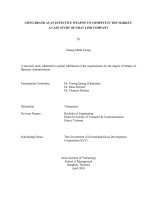
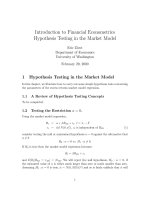
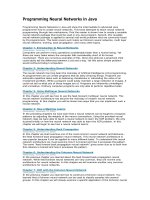
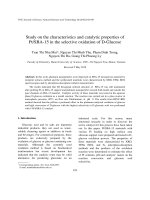
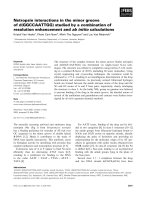

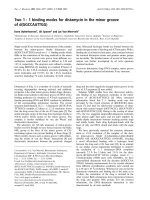

![neural networks in finance gaining predictive edge in the market [mcnelis p d ]](https://media.store123doc.com/images/document/14/y/kh/medium_GjH4xSZlGV.jpg)
